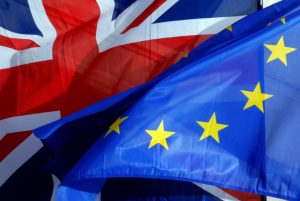Mar 17, 2017 | BEP, Britain, celebration, coins, education

2016 Canada Lucky Four-Leaf Clover 1 oz Silver Coin
Patrick was not welcomed when he arrived but worked with the society to convert them to Christianity. Although most of his writings portrayed that he was probably more successful than he was, but after working with the people, first in the northern regions of Ireland, he did find success. He once wrote that he baptized thousands of people and some have written that he baptized hundreds on a single day. Using the native three-leaf shamrock to describe the Holy Trinity, Patrick was promoted bishop and apostle of Ireland. He died on March 17, 461 in Saul, where he founded his first church.
For thousands of years, the Irish have observed the day of Saint Patrick’s death as a religious holiday, attending church in the morning and celebrating with food and drink in the afternoon. The first St. Patrick’s Day parade was celebrated in 1762 when Irish soldiers serving in the English military marched through New York City.
With Saint Patrick’s Day, talk about “the luck of the Irish” and associate the shamrock of four-leaf clover as a lucky symbol. I was thinking if there are coins or currency that would bring you luck. After searching around online for lucky coins there was a common theme: something that is special to you. Here is a composite of the types of lucky coins:
- Coins from the year of your birth: I have helped several people buy proof and mint sets of coins from the year they were born. On one of my father’s milestone birthdays, I bought uncirculated coins from the year of his birth and had them slabbed in an NGC multi-coin holder when they were still being offered.
- Coins from a country special to you: On one of my wife’s milestone birthdays, I purchased a Canadian proof set from the year of her birth. Although she was born in the United States, her parents were from Canada and it has become a special collectible.
- Coins that have a special meaning: A friend keeps a Morgan Dollar in his top desk drawer. The desk used to belong to his grandfather who kept that coin as his “emergency dollar” during the Great Depression.
- Coins found during a happy or coincidental time: A client once showed me a 1958 Cuban peso that he found on the street in Miami that he keeps as a pocket piece. He decided that since it was the same year his family fled Cuba, it was a fortuitous find.
- Coins of a specific design: Sometimes the design may be added to the coin. I once met someone who had several Love Tokens from his relatives he says it is his family’s way of watching over him.
A silver sixpence in her shoe

1962 British Sixpence
Feng Shui

Feng Shui Coins
The number of coins tied together is important. One coin is believed to promote loneliness and will leave you empty. Two is better but does not have the power of rebirth that three does. Three coins tied together represents the heavens, earth, and mankind. Four represents death and not something that would promote Feng Shui. The Chinese do not know why five is not lucky but this is accepted. While three is considered proper Feng Shui, making it more powerful would be three-times-three, or nine, coins.
For luck, you can hang Feng Shui coins on the on the inside of your front door, not the outside. You want the luck inside. Do not hang your Feng Shui coins on your back door because it will luck to leave your house.
You can place three Feng Shui coins on top of items to bring them luck. When you do this, it is important to place the Yang side facing up to invite the luck to protect your item. The Yang side is the side with the four characters.
When giving a gift, attach three Feng Shui coins to the package to bring double happiness. It tells the recipient that with the gift you are also wishing them wealth, prosperity, and happiness. Doing this will add to your Feng Shui for giving generous and unselfish wishes.
Numerology and currency
Numerology is the belief in the divine or mystical relationship between numbers and the physical world. Many people practice a mild form of numerology called a “lucky number.” For those who believe in some type of numerology can turn to the serial number of currency to add to their collection.
One of the more expensive aspects of notaphily is the collection of patterns numbers. Typical patterns are as follows:
- Solid: every digit the same
- Ladder: numbers that count up, like 12345678, or down, like 98765432
- Low or High numbers
- Radar numbers: when the serial number repeats forward and backward, like 12344321
- Repeater numbers: when the serial number is repeated, like 12341234
- Super Repeater: pairs of numbers that repeat four times, like 36363636
- Double Quad: two pairs of four numbers, like 88889999
- Seven of a kind: both in a row or seven of the same number
Notes that represent dates can bring luck such as one that has your birthdate. For someone born on March 17, 1977, finding a note with the serial number 03171977 or even 19770317 could be very lucky. Since the numbers reset for every series and there are 12 Federal Reserve branches used as a prefix, you have quite a few chances of finding these.

$1 Lucky 777 Note
The BEP also sells lucky money that includes the Lucky 7 set. These notes have a serial number that begins with three 7s. You can also buy notes in special Chinese holders with serial numbers that begin with “8888” and “168.” In Chinese, the “eight” sounds similar to the word for “prosper” or “wealth.” Selling the Lucky 8888 note is to help promote prosperity and wealth.
The “168 Prosperity Forever” note plays on the Mandarin pronunciation of the number that sounds similar to “prosperity forever.” If the BEP used the Cantonese pronunciation, they would have the use the serial numbers beginning “768.”
Go find your lucky coin and may you have health and prosperity.
Credits
- Canadian coin image courtesy of the Royal Canadian Mint
- Sixpence image courtesy of Wikipedia
- Feng Shui coins image courtesy of eBay user “technology-onsale“
- Lucky 777 Note courtesy of the Bureau of Engraving and Printing
Jan 3, 2017 | Britain, commentary, currency, news
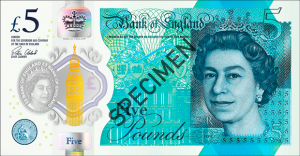
Bank of England £5 Polymer note
To be a vegan means that you do not use or consume any animal product. It is a movement that began in the 16th century but organized in the 19th century as part of a philosophy to reject the commodity status of animals. In fact, the term “vegan” did not enter the language in 1944 when Donald Watson co-founded the Vegan Society in England. Fundamentally, I do not have a problem with vegans or veganism but it has recently crossed the line where my tolerance is being tested.
In September, the release a new £5 polymer note featuring the portrait of former Prime Minister Winston Churchill. Even though there were concerns raised at the time of the release, in November, a vegan activist names Steffi Rox asked the Bank of England if the new £5 polymer note contains tallow on Twitter. The Bank of England responded that “there is a trace of tallow in the polymer pellets used in the base substrate of the polymer £5 notes.”
Which was followed up by Ms. Rox asking “what consideration was given to #vegans & their human rights in the making of these?”
This exchange reverberated around the world to all countries that use polymer notes including Australia that has been circulating polymer notes since 1992.
The Bank of England issued a statement confirming that the pellets used to make the polymer substrate contains trace amounts of tallow.
The new notes are produced on a product called Guardian manufactured by Innovia Security. Innovia is the company formed in Australia following the research and production of the polymer substrate by the Reserve Bank of Australia. Although Innovia has not issued a formal statement, press reports note that the company admits that tallow is used in the resin it sources from a supplier to make the polymer pellets used by the banks in the manufacture for the substrate that is printed for currency.
Tallow is made from suet, the fatty deposits around the organs of cows and sheep. It is a byproduct of the process of butchering a cow for its meat and hides. In its natural form, suet is only useful for cooking and some preservation. When it is rendered (by boiling) into tallow, it is used to manufacture soap, candles, and lubricants. The use of tallow in even the most synthetic lubricant is ubiquitous. Machines used to harvest crops or grease moving parts in automobiles have tallow in them.
Tallow is part of using the whole animal rather than killing it for parts and discarding the rest. It is the concept that animal rights activists preach. On this, I agree with their position.
But it isn’t like the Bank of England or Innovia is dumping tallow into its manufacturing process. Based on what how it was explained to me by a chemist familiar with polymer manufacturing but not associated with Innovia or the polymer banknote process, tallow is likely used in the resin as part of the pellet manufacturing process. The resin acts as a binder but has to manufactured in a way that prevents it from sticking to everything. Small amounts of tallow are used as a lubricant to make the resin to prevent it from sticking to the machinery. Trace amounts of tallow remain in the resin in the same manner oil would remain on your tires if you rolled over an oil slick on the street.
Just because there is oil on your tires does not mean your tires are made of oil. But the oil remains a trace element on your tires and continues to exist until removed using some type of friction. But it is such a small trace, you never notice.
The same can be said of the tallow. The chemist said that if there are more than 5 parts per million of tallow in the notes then that the manufacturing process should be questioned. Aside from suggesting the process is dirty the proportions may make the polymer unstable and less useful to use as currency. Its 25-year usage in circulation suggests that there are no problems in the manufacturing process.
To understand what 5 parts per million would mean, you can also think of it as one-two thousandth of one percent.
With all due respect to vegans, you are probably breathing more dander in a single day than you are touching tallow in all of the polymer banknotes that cross your paths. For those of us who know that tallow is used in all sorts of lubrication products, especially those used in transportation, you cannot get away from its use. It is everywhere. You need to better educate yourselves before taking a stand against one-two thousandth of one percent because you look like hypocrites.
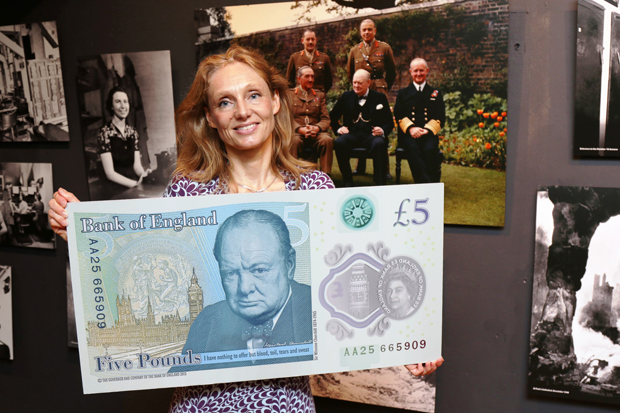
Victoria Cleland, Chief Cashier at the Bank of England, presenting the Churchill War Rooms with their New Fiver
Jun 22, 2016 | Britain, economy, markets, medals, news
While there is enough going on with U.S. politics to make one’s head spin, on Thursday, June 23 the United Kingdom will hold a nationwide vote on whether the U.K. should leave the European Union. The last time the U.K. held a referendum on joining the E.U. was in 1975, which predates the modern European Union. It is called “Brexit,” a portmanteau of the term “Britain Exit,” as in should Britain exit the E.U.?
The European Union was formed after World War II in various forms in an attempt to collectively rebuild Europe by integrating their resources. The first formal attempt was the Treaty of Rome in 1957 signed by Belgium, France, Italy, Luxembourg, the Netherlands and West Germany to create the European Economic Community (EEC) and established a customs union. What we know today as the European Union was established when the Maastricht Treaty became effective in 1993.
As part of the integration under the E.U. is the common currency known as the Euro. First distributed in 1999 with 14 participating nations, now includes 19 of the 28 nations plus the Vatican, Monaco, and San Marino who are not formally members of the E.U. The United Kingdom (England, Northern Ireland, Scotland, and Whales) continues to use the pound sterling, sometimes referred to the Great Britain Pound. Ireland, sovereign from the United Kingdom, uses the euro.

British Prime Minister David Cameron
Interestingly, many of the arguments for leaving the E.U. are similar to those being applied by the apparent nominee for the Republican Party in the United States while those campaigning to remain in the E.U. are similar to the apparent Democratic Party nominee. It just goes to prove that regardless of which side of the pond you live, politics is polarizing.
For those of us Yanks who want to learn more, BBC News has published a good overview with links to more in-depth that you can click here to read it, if interested.
So why is this significant for a coin collector’s blog? We do look at economic matters affecting collecting including those whose collection are being put together for speculation including the purchase of bullion-based numismatics. Also, the outcome could not only affect the world economic system but could also have an impact for those who collect foreign coins.
If the U.K. votes to remain in the E.U. then the status quo remains. The British will go back to their partisan politics and scratch their heads over the U.S.’s partisan politics known as the 2016 presidential election. Markets that have tightened in anticipation of what Brexit may mean could see this as a temporary reprieve.
If the U.K. votes to leave the E.U. the markets may not like it and the economy can go into a freefall. Markets do not like uncertainty and a vote for the U.K. to leave the E.U. would bring about the uncertainty of “what happens next?” and “now what?” Business leaders, who are largely in favor of remaining the in E.U., has noted that it makes it easier for them to move money, people and products around the world. What happens when those doors are closed?
As we have seen when economies are uncertain, markets react by selling off speculative assets, like stocks, and running to safer investments like trustworthy bonds and precious metals. In the last three weeks in the run up to Brexit, gold is up $56 (4.6-percent) in the last three weeks and silver is up $1.41 (8.8-percent). Both are off their annual highs set on June 16 when published polls are suggesting that Stay has a lead greater than the margin of error over Leave.
-
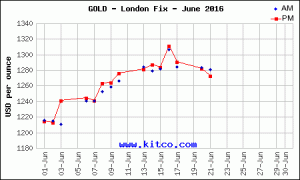
-
June gold prices through June 22
-

-
June silver prices through June 22
NOTE: Charts do not update

Sample of the ballot that will be used for the EU Referendum “Brexit” vote
Market watchers can watch what happens to the Tokyo Nikkei 225 market index and Hong Kong’s Hang Seng Index. Both are the major indexes in the Asia/Pacific region and will be around their midday trading sessions on Friday.
Collectors looking for something numismatic to add to their collection might want to consider the In/Out UK EU Referendum Medallion produced by Chard(1964), a British metals dealer. These copper medals were produced for the Britons who were undecided. Flip the medal before you vote to decide whether to remain or leave. The Remain side has the E.U. flag surrounded by “Remain,” “Better Together,” “United,” and “Stronger in Europe.” The Leave side has the British Union Jack with “Brexit,” “Independence,” “Leave,” and “Sovereignty.”
Medals are 31mm in diameter and weighs 14 grams. They come in pure copper or Abyssinian Gold, a type of brass made of 90-percent copper and 10-percent zinc that has a gold-like color. They can be purchased for £2.95 each ($4.33 at the current exchange rate) plus shipping (estimated at £6.00 or $8.80) directly from Chard’s website.
-
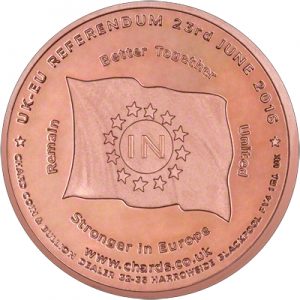
-
Chard Brexit Medal “In” side
-
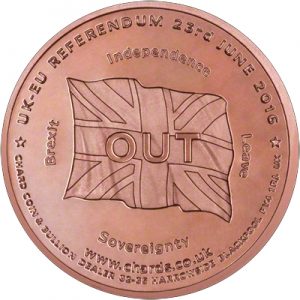
-
Chard Brexit Medal “Out” side
Credits
- Brexit combined flags image: Credit Philippe Wojazer/Reuters via the New York Times.
- Image of PM Cameron is an official photo downloaded from Wikipedia.
- Static metals graphs courtesy of Kitco.
- Referendum Ballot image courtesy of Wikipedia.
- Brexit Medal images courtesy of Chard.
Oct 27, 2015 | Britain, bullion, coins, nclt, video
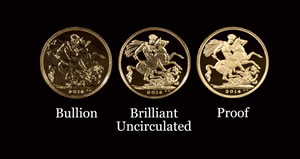
Royal Mint Striking Standards
As part of the article and video they discuss the differences between the three types of uncirculated commemorative coin finish: Proof, Brilliant Uncirculated, and Bullion. For the Royal Mint, proof are the highest standards followed by brilliant uncirculated then bullion.
While this may be intuitive to experienced collectors, novice and new collectors may be confused by the difference. The Royal Mint does a very good job at explaining the difference in a short, well produced video. It should be interesting to the beginning and expert collector to see how another mint does their work.
Image and video courtesy of the Royal Mint.
Aug 7, 2015 | Britain, coins, commentary, policy, US Mint
As part of my perusal of the Internet looking for numismatic-related stories, I stumbled upon an article at the website for The Guardian about the Royal Mint’s operating income and profits. The story touted how the Royal Mint, whose history can be traced back over 1,000 years, increased over 70-percent from the previous year.
Using The Guardian’s reporting, I wondered how the Royal Mint would stack up against the U.S. Mint. Even though the story was published on July 23, 2015 and the U.S. Mint’s data is for Fiscal Year 2014 that ended on September 30, 2014, I am using the conversion rate of at the time I write this of £1 is equivalent to $1.55.

Revenues
The Guardian reported that the Royal Mint earned £260 million in revenues. This is equivalent to just over $404 million. In contrast, the U.S. Mint boasted revenues of over $3.1 billion or a bit over £1.995 billion. Yes, that is BILLION with a “B.” While the Royal Mint’s revenue was depicted as being the most in the institution’s history, the U.S. Mint’s record revenues came in 2011 when it earned $4.970 billion.
Profit
What good is making money if there are no profits. The Royal Mint reported a record profit of £11.5 million or just over $17.7 million. The U.S. Mint did slightly better by reporting a seigniorage of $367.9 million or more than £236.756 million. Even if you take it as a percentage, the Royal Mint’s profit margin is 4.38-percent while the U.S. Mint has a profit margin of 11.86-percent.
Benefit to their respective governments
The Royal Mint is wholly owned by the British Treasury. They pay a £4 million ($6.218 million) dividend to the British government. By law, the seigniorage earned by the U.S. Mint is deposited in their Public Enterprise Fund. The Treasury Department requests a budget for the U.S. Mint which is then approved by congress. The funds are withdrawn from the Public Enterprise Fund. Allowing for overages, the Secretary of the Treasury then transfers the rest of the money to the U.S. General Funds where it is used to pay whatever the government needs. In 2014, $272 million (£174.971 million) was deposited into the General Funds, more than 43-times the dividend that the Royal Mint pays the British government.
The U.S. Mint is the most profitable agency in the United States government. No other mint in the world can match the U.S. Mint’s production, income, and profit. The U.S. Mint even out performs private industry. The average profit margin in the United States is 5.1-percent.
The next time someone complains that it costs too much to make a specific coin, remind them that the U.S. Mint provides more benefit to the government than the loss of a little profit on a few coins.
Royal Mint logo courtesy of the Royal Mint.
U.S. Mint seal courtesy of the United States Department of the Treasury.
Nov 11, 2012 | Australia, Britain, coins, history
In Flanders Fields
by John McCrae, May 1915
In Flanders fields the poppies blow
Between the crosses, row on row,
That mark our place; and in the sky
The larks, still bravely singing, fly
Scarce heard amid the guns below.
We are the Dead. Short days ago
We lived, felt dawn, saw sunset glow,
Loved and were loved, and now we lie
In Flanders fields.
Take up our quarrel with the foe:
To you from failing hands we throw
The torch; be yours to hold it high.
If ye break faith with us who die
We shall not sleep, though poppies grow
In Flanders fields.
“In Flanders Fields” was written during World War I by Lieutenant Colonel John McCrae, a Canadian physician stationed in northern France. Aside from being a physician, he was a teacher, poet, and author. McCrea was appointed as a field surgeon and was in charge of a field hospital during the Second Battle of Ypres when his friend and former student Lieutenant Alexis Helmer was killed in the battle. The death and funeral of his friend inspired McCrae to write the poem.
“In Flanders Fields” was published anonymously in the British magazine Punch on December 8, 1915. However, the index for the year printed only a few weeks later attributed the poem to McCrea. The poem became one of the most popular of the war and was extensively printed in the United States while its leaders were debated whether to join the war.
McCrae died of pneumonia on January 28, 1918 while commanding No. 3 Canadian General Hospital (McGill) at Boulogne. He was buried with full military honors at Wimereaux Cemetery near the English Channel 3 miles from Boulogne.

2004 Canada Poppy Quarter, the first colorized coin ever issued for circulation by any mint.
The remembrance poppy is not as strong a symbol in the United States since the nation did not declare war on Germany until April 1917. The American Legion has used the poppy as part of its fund raising efforts.
Maybe the United States should embrace the poppy as well. Why not create a commemorative coin with a colored poppy as the design and use the seignorage from the sales to support the work of the Department of Veterans Affairs? How about changing the reverse of the Roosevelt Dime to be a red-colored poppy to raise awareness of all our veterans? Using the Roosevelt Dime would give it a needed refresh and would tie both World Wars in one coin. Then the U.S. Mint could strike special silver dime for sale to the public.
Maybe it is an idea whose time has come.
Jul 21, 2012 | Britain, medals, Royal Mint, video
With the 2012 Summer Olympics starting next week in London, the folks at CNN Money did a report about the making of the medals by the Royal Mint.
Medals made for the XXX Olympiad in London are the largest medals ever made for a summer Olympics. Their specifications are as:
- Diameter: 85mm (approx. 3.346 inches)
- Thickness: 7mm
- Weight: 412g (approx. 14.5 ounces)
- Designer: David Watkins
- Obverse Design: Nike with Panathinaiko Stadium in the background
- Reverse Design: The River Thames and the London Games logo with angled lines in the background
- Composition of Gold Medal: 92.5% silver, 6.16% copper, 1.34% gold
- Composition of Silver Medal: 92.5% silver, 7.5% copper
- Composition of Bronze Medal: 97% copper, 0.5% tin, 2.5% zinc
The metals used to make the medals were supplied by Rio Tinto and was mined at their Kennecott Utah Copper Mine and Oyu Tolgol project in Mongolia.
Here is the CNN Money report about the making of the medals by the Royal Mint:
Image of the London 2012 Olympic Medals courtesy of London Organising Committee of the Olympic and Paralympic Games
Video courtesy of CNN Money
Dec 29, 2010 | Britain, foreign, silver
Silver can bring out the best in nearly every design. Another silver coin worth collecting is the Britannia. After joining the United States and other countries to offer gold bullion coins in 1987, the Royal Mint celebrated the tenth anniversary of their program by introducing a £2 silver coin. Silver Britannias are struck in what is called Britannia silver, an alloy consisting of 958 parts per thousand silver. As a comparison, sterling silver consists of 925 parts per thousand silver. Comparatively, the American Silver Eagle contains 999 parts per thousand silver and the Canadian Maple Leaf consists of 999.9 parts per thousand silver. The balance of the alloy is usually copper.
Britannia was originally the Latin name that the Roman Empire gave to the island of Great Britain and its possessions. After the fall of the Roman Empire it had lost most symbolic meaning until the rise of British influence and being renewed during the time of Queen Victoria. Still depicted as a young woman with brown or golden hair, she kept her Corinthian helmet and her white robes, but now she held Poseidon’s three-pronged trident and often stood in the ocean, representing British naval power. She also usually held or stood beside a Greek hoplon shield which sports the British Union Jack. At her feet was often the British Lion, the national animal of England. Britannia first appeared on the farthing in 1672, followed by the halfpenny later the same year under Charles II.
When introduced in 1997, the Silver Britannia was minted with the official “hid Portrait” of HM Queen Elizabeth II on the obverse. This portrait was designed by Raphael Maklouf FRSA and shows the Queen with the Royal Diadem which she wears on her way to and from the State Opening of Parliament. The fourth official portrait of Her Majesty the Queen was introduced for all Commonwealth coinage in 1998. It is the work of sculptor Ian Rank-Broadley FRBS, FSNAD. Her Majesty is wearing the tiara which was used in an earlier coinage portrait by Arnold Machin. The Queen is shown facing right, in accordance with a tradition dating back to the seventeenth century, where successive monarchs face in alternative directions on the coinage.
From their introduction in 1987, the gold Britannia coins used the standing Britannia design on the reverse. On the tenth anniversary of the program and the introduction of the silver Britannia, a new deisign was created. The design was a figure of Britannia driving a chariot in the manner of Boudica was designed by Philip Nathan. Boudica, also know as Boadicea, was ruler of the Iceni tribe in eastern England and Queen of the Britons. She led her forces in revolt against the Romans and sacked Colchester, St. Albans, and London before being defeated by the Roman governor, Suetonius Paulinus. She died in the year 62 CE. This design was used in 1997, 1999, and 2006.
Following the successful launch of the silver Britannia coins, the Royal Mint returned to the standing Britannia design. Created by Philip Nathan, Britannia is depicted adorned in flowing robes standing proud in defense of Britain’s shores. The design recalls the design used on florins of Edward VII. this design also appeared in 2000, 2002, 2004, and 2006.
 With a few other designs mixed in, the 2010 is also a single year design designed by Suzie Amit who said that she wanted to portray Britannia as a strong and courageous looking but not overly warlike woman—more peaceful and protective. The coin is struck with shiny surfaces without contrast from frosted designs. Unfortunately, it made it difficult to image. Although this image does not capture its beauty, it is a very nice design and worthy of completing my one ounce Silver Britannia collection.
With a few other designs mixed in, the 2010 is also a single year design designed by Suzie Amit who said that she wanted to portray Britannia as a strong and courageous looking but not overly warlike woman—more peaceful and protective. The coin is struck with shiny surfaces without contrast from frosted designs. Unfortunately, it made it difficult to image. Although this image does not capture its beauty, it is a very nice design and worthy of completing my one ounce Silver Britannia collection.
American Silver Eagles, Chinese Pandas, and Great Britain Britannias are not only beautiful silver coins, but make a nice set to collect. Even with silver prices on the rise, they do make nice sets.
Apr 11, 2009 | Britain, fun, gold
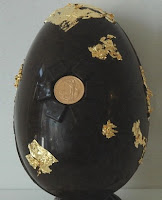 Even in a down market, there is always someone ready to capitalize on those who still have the money to afford extravagance. In Great Britain, the high-end retailer Selvridges is selling Melt’s Recession Proof Egg. Melt, the Selfidges house brand, is offering a hand-made to order chocolate egg made with a one-ounce gold bullion Britannia coin and decorated with 18-karat gold leaf.
Even in a down market, there is always someone ready to capitalize on those who still have the money to afford extravagance. In Great Britain, the high-end retailer Selvridges is selling Melt’s Recession Proof Egg. Melt, the Selfidges house brand, is offering a hand-made to order chocolate egg made with a one-ounce gold bullion Britannia coin and decorated with 18-karat gold leaf.
Gold is currently $880.80 per ounce (£600.31 at the current exchange rate).
If you have a spare £1,000 ($1,467.25) and happen to be in the area of Selfridges’ Oxford Street store in London, you might want to pick up a unique easter gift.
Image courtesy of Selfridges.
Jun 2, 2008 | Britain, Canada, coins
Needing to catch up on a number of tasks this weekend, I decided to take time out and go through my pocket change. While I like to examine my change, sometimes it is not possible. So I drop the coins in a small box and promise myself to search them later. The box was overflowing making it time to search.
First, I separate quarters. Quarters are easier to examine because of their size and the fewer errors I have found. I also fill up coin tubes so that my wife has soda money for work. While searching this small box, I found two 1976 quarter with the Drummer Boy Reverse designed by Jack Ahr. It still remains one of my favorite designs.
While searching the quarters, I found a 1992 Great Britain 10 pence coin. This coin is 24.5 mm in diameter and 1.8 mm thick with a reeded edge. A US quarter dollar is 24.26 mm and 1.75 mm thick with a reeded edge. Although the design is different, the size and the silver-like color could easily have this coin mistaken for a US quarter. My only problem is that even at the current exchange rate (it takes $2 to equal £1) the coin’s value is 20-cents leaving me 5-cents short!
Within the nickels, I was able to find a well circulated 1954-S coin. It is not worth much in its current condition, but it is nice to find a coin older than me and with the mint mark on the reverse.
When searching change, there seems to always be more to find within the little brown coins that many want to complain about and eliminate. For change searching, pennies usually yield some of the more interesting finds. Aside from the number of early Memorial reverse copper cents, I was able to find 1972-S and 1974-S cents. For someone on the east coast, finding San Francisco Mint coins in change is not usual.
Of course I found a few wheat back cents. The oldest is a well circulated 1941 cent. Two others, 1956-D and 1957, are in good to very good condition with a nice, even chocolate brown toning.
We cannot forgot our neighbors to the north. With the dollar about on par with the Canadian dollar, the prospect of making a virtual profit on finding Canadian cents induces dreams of past economic times. But this time, I found two 1979 and one 2000 cents. The 1979 cents have the modified tiara portrait, a smaller portrait from previous versions, and 3.26 grams of .980 copper. It contains 2.57 (US) cents worth of metals.
The copper-plated zinc 2000 Canadian cent, contains about one (US) cent worth of zinc.
If nothing else, it gave me a couple of hours to relax.






